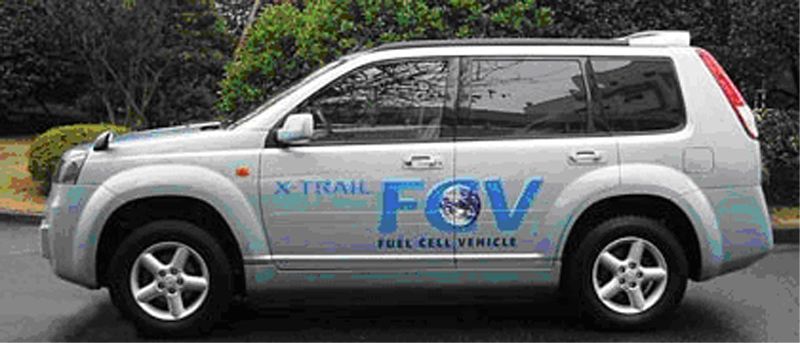
|
BRHS /
Transport Cars And Light TrucksFrom 1967 to 2003 about 110 FC powered prototype cars and light trucks have been developed world-wide as well as some 36 ICE cars. Counting the vehicles of which more than one example has been built, a total of 230 FC and 66 ICE hydrogen vehicle prototypes have been put on the road. Most of these vehicles were built after 1995. For the propulsion of passenger cars and light trucks hydrogen may be used in internal combustion engines as well as in fuel cells. Whereas in cars driving on urban cycle patterns the FC seems to be the preferred drive system, ICE with hydrogen could be competitive for long-distance motorway-type driving modes in terms of efficiency and in the transition phase to a wider use of hydrogen as a vehicle fuel Invalid BibTex Entry!. Figure 1 shows the power train of a simple FC vehicle. The fuel cell generates electricity, which drives an eclectric motor. Examples showing a FC and a ICE vehicle are given below. A FC vehicle is illustrated by a Nissan X-Trail Fuel Cell Vehicle (figure 2) and an ICE vehicle by a BMW 750h (figure 3).  Figure 2: Nissan X-Trail Fuel Cell vehicle. X-Trail FCV is a high-pressured hydrogen-powered vehicle that delivers clean power, without noxious emissions. It employs elements of a variety of technologies, including electric vehicle (EV), hybrid electric vehicle (HEV), and compressed natural gas vehicle (CNGV) technology. It is equipped with a compact, high-performance lithium-ion battery pack [NISSAN] At the core of the X-Trail FCV is the Nissan-exclusive Super Motor. In an ordinary motor, a rotor fitted with permanent magnets rotates around electromagnets (stator) to generate power that is output through one shaft. The Super Motor incorporates a new technique of applying compound current to the electromagnets and has two rotors positioned both on the inside and outside of one stator, allowing power to be delivered through two shafts. The Super Motor can achieve improvements in compactness and efficiency compared with the use of two motors. Additionally, it controls the power of each shaft separately, making it possible to drive right and left independently, enhancing dynamic performance and stability. One motor package also incorporates the dual functions of a motor and a generator. The Super Motor can be utilized in a wide variety of applications, including on fuel cell vehicles and hybrid vehicles, which benefit from the use of its generator function. Powering the Super Motor are high-output lithium-ion batteries that utilize a laminated lithium-ion cell in place of the conventional cylindrical shape. The use of a laminated cell as an automobile battery, which has a high current rate, requires larger terminals. The sealing performance of the cell also becomes an issue because of the gas produced by repeating charging and discharging cycles. BMW focus their development solely on ICE driven vehicles fuelled by liquid hydrogen. According to BMW an evolution of the existing ICE technology offers much better power density and propulsion efficiency as compared to fuel cells. One example of a BMW hydrogen vehicle, the 750h, is shown in figure 3. The 750h is powered by a 5.4-liter V12, featuring bi-VANOS variable valve timing, Valvetronic variable intake runners, and a fully variable intake manifold. The 750h can use either hydrogen or premium unleaded gasoline. Running on hydrogen, the 750h produces 150kW/200hp and can achieve a top speed of 215 km/h. The cruising range is 300 km. Added to the 640 km range of the normal fuel tank, the 750h can go 960 km between fill-ups. An Auxiliary Power Unit (APU) runs the 750h's power-consuming features. The APU operates on a 5kW Polymer Electrolyte Membrane (PEM) fuel cell that is independent of the engine, thanks to a direct hydrogen feed from the trunk-mounted tank. This means power accessories like air conditioning can be operated when the engine is shut off, saving 3.78 l of gas for every 280 km of city driving. BMW has announced that they expect a wide market entry not before 2010. The development of FC powered cars by other manufacturers such as DaimlerChrysler, Ford, GM/Opel, Toyota, Honda and Nissan has also led to a number of prototype vehicles on the road in Europe, Japan and the U.S. The complexity of hydrogen drive-systems is viewed as medium for the technologies both for the FC and ICE. If on-board reforming from hydrogen containing carbon based fuels is preferred, the system complexity rises due to the complex processing hardware involved which is required for the highly dynamic operating conditions. The technical maturity of both ICE and FC (without on-board reforming) for cars is judged as medium by the car industry as prototype vehicles are on the roads and field tests in the hundreds are imminent. Technical and economic challenges remain to be solved. For FC drive systems these are cost reduction by e.g. minimization of catalyst demand, material development towards e.g. high temperature membranes, extended driving range, storage system integration, further improvement of the onboard fuel reforming technology, cold start performance and reliability/operating life. For ICE vehicles improved fuel injection systems utilizing the refrigeration energy of liquid hydrogen and the hydrogen-mono-fuel performance have to be optimized. References: Invalid BibTex Entry! |